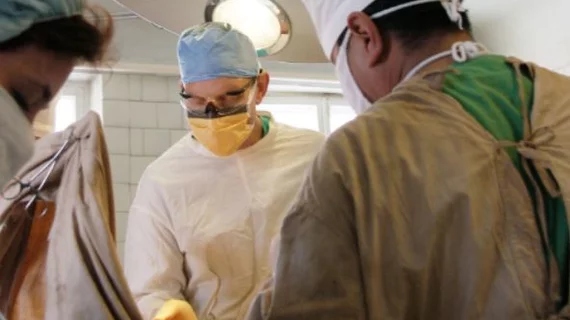Despite its relative rarity in clinical practice, the Ross procedure provides a survival benefit over mechanical aortic valve replacement in young and middle-aged patients, suggests a meta-analysis published in JAMA Cardiology and presented at the European Society of Cardiology Congress in Munich.
The meta-analysis included 18 studies encompassing 1,552 patients who underwent a Ross operation and 1,964 who underwent mechanical aortic valve replacement. Over a median follow-up of 5.8 years, those receiving the Ross procedure were 46 percent less likely to die of any cause, 74 percent less likely to suffer a stroke and 83 percent less likely to experience major bleeding. They also showed significant improvements on a quality-of-life score compared to patients receiving mechanical valves, and a 58 percent reduction in valve- or heart-related mortality.
The Ross procedure involves using a patient’s own pulmonary valve to replace a diseased aortic valve. Pulmonary tissue from a deceased donor is then used to replace the pulmonary valve. First described in 1967, the technique has become less popular over the last two decades due to its perceived complexity, according to researchers led by Amine Mazine, MD, MSc, a cardiac surgeon with the University of Toronto.
“In contrast to mechanical aortic valve replacement, the Ross procedure alleviates the need for lifelong anticoagulation through the avoidance of prosthetic valve material,” Mazine and colleagues wrote. “This advantage is particularly significant in young and middle-aged adults who, because of their longer anticipated life expectancy and active lifestyle, present a higher cumulative lifetime risk of prosthesis-related complications. Second, because the pulmonary autograft is a living structure, it has the potential to reproduce the sophisticated functions of the normal aortic root.”
There was a downside of the Ross procedure highlighted in the meta-analysis: Those patients were 76 percent more likely to require another valve surgery during follow-up. The researchers said this is likely because of risks associated with using allograft transplants, as well as the fact that two valves are involved in the Ross procedure versus one in mechanical valve replacement.
“The causes of reoperation are largely preventable and, when they occur, can be treated by modern percutaneous approaches or low-risk reoperation in a center with experienced practitioners,” Magdi Yacoub, OM, with Harefield Hospital in London, wrote in a related editorial.
Despite the evidence supporting the Ross procedure, Mazine et al. said appropriate patient selection remains crucial in deciding the optimal valve replacement strategy.
“Superior survival with the Ross procedure is likely due to the ability of a living graft to adapt, but this surgery is not for everyone,” Mazine said in a press release. “It needs to be the right patient undergoing the procedure to ensure the best outcomes.”
The median follow-up of 5.8 years was likely too short to address the “long-term impact of structural valve deterioration following the Ross procedure,” the researchers acknowledged. However, they believe the superior survival is enough to outweigh the increased risk of reoperation.
Another limitation of the meta-analysis was its reliance on mostly observational studies, which introduces the likelihood of unmeasured confounding and eliminates the ability to establish causality. Mazine and colleagues said a randomized clinical trial with longer-term follow-up could offer a better comparison between the two approaches, but Yacoub noted such a study might be unrealistic.
“The difficulties of setting up such trials in the current era include a selection bias that does not represent the real world and the need for a large number of patients and a long follow-up period, not to mention an almost prohibitive cost,” he wrote. “It could be argued that there is already a sufficient body of evidence to justify the increased use of the Ross operation in health care centers with experienced staff, coupled with establishing comprehensive databases, such as the German Ross Registry.”

